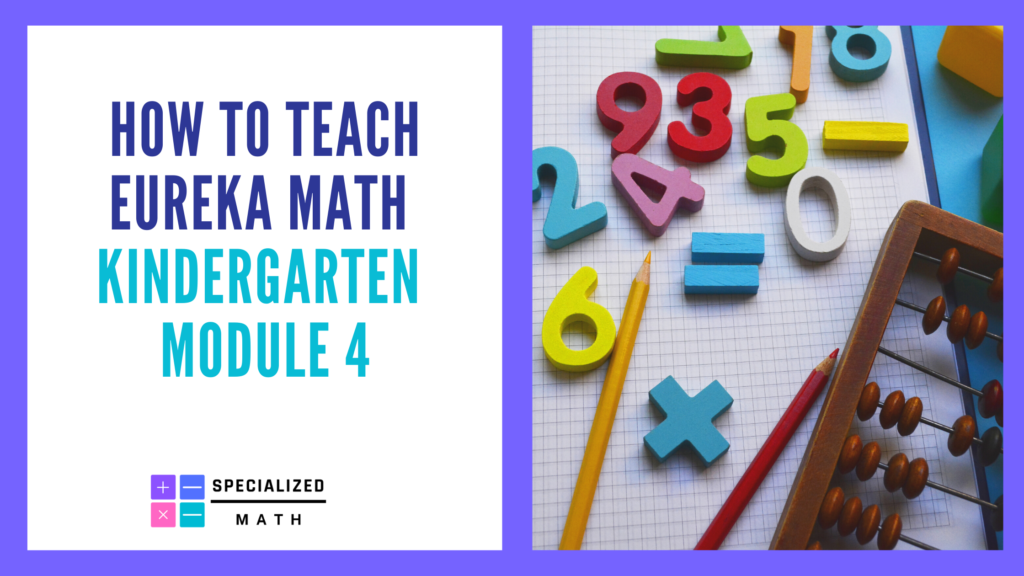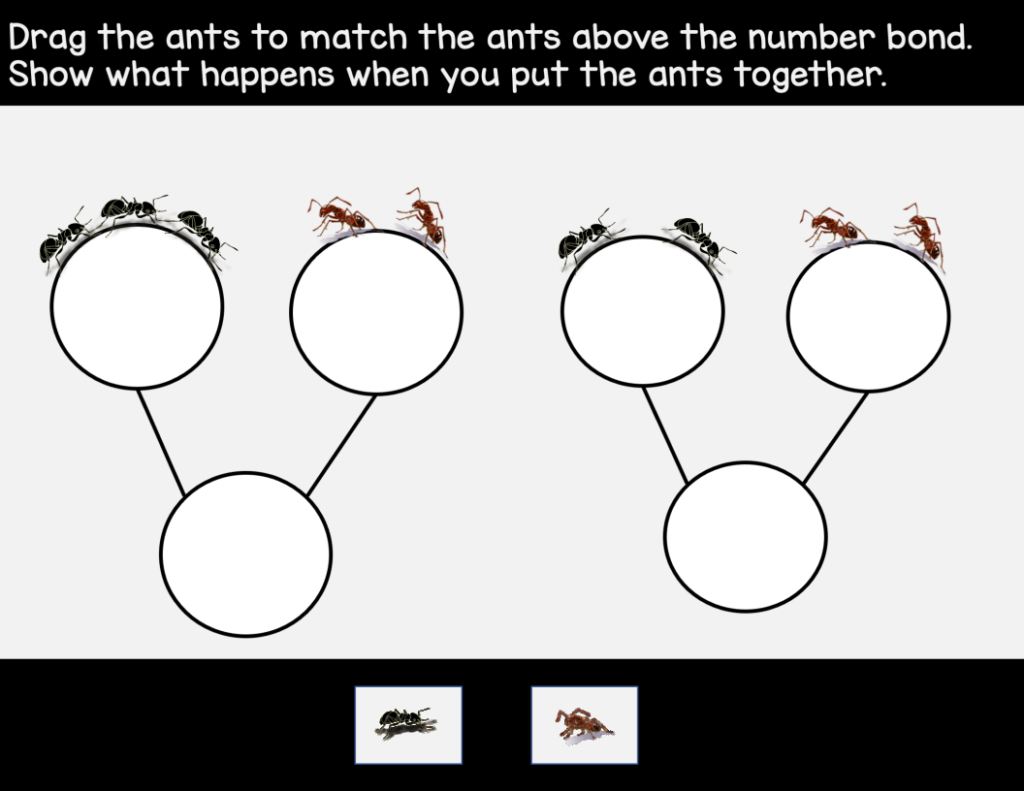Eureka Math is broken down into six modules at the kindergarten level. Kindergarteners learn to represent, relate, and operate on whole numbers, initially with sets of objects. They also learn to describe shapes and space. Majority of the time in Kindergarten should be spent on work with numbers, a foundation for much of the future math work in a student’s school career.
Eureka Math Kindergarten, Module 4 is where students are beginning to work with addition and subtraction for the first time. This is a critical Module for students to engage in and be successful with as it sets the foundation for understanding the four operations in future grade levels.
It may even be necessary to review these lessons for students in higher grades who are demonstrating missing foundational knowledge or who have a math disability and difficulties.
Focus Standards
The focus standards for Kindergarten, Module 4 are:
K.OA.1 – Represent addition and subtraction with objects, fingers, mental images, drawings, sounds (e.g., claps), acting out situations, verbal explanations, expressions, or equations. (Drawings need not show details, but should show the mathematics in the problem. This applies wherever drawings are mentioned in the Standards.)
K.OA.2 – Solve addition and subtraction word problems, and add and subtract within 10, e.g., by using objects or drawings to represent the problem.
K.OA.3 – Decompose numbers less than or equal to 10 into pairs in more than one way, e.g., by using objects or drawings, and record each decomposition by a drawing or equation (e.g., 5 = 2 + 3 and 5 = 4 + 1).
K.OA.4 – For any number from 1 to 9, find the number that makes 10 when added to the given number, e.g., by using objects or drawings, and record the answer with a drawing or equation.
K.OA.5 – Fluently add and subtract within 5.
Prerequisite Standards
The prerequisite standards, or standards that students should have mastered prior to engaging in this module are:
K.CC.A.3 – Write numbers from 0 to 20. Represent a number of objects with a written numeral 0-20 (with 0 representing a count of no objects).
K.CC.B.4c – Understand that each successive number name refers to a quantity that is one larger.
Vocabulary
Newly introduced vocabulary for Kindergarten Module 4 includes: addition, addition and subtraction sentences, make 10, minus (-), number bond, number pairs or partners, part, put together, subtraction, take apart, take away, and whole.
Topics for Eureka Math Kindergarten Module 4
Eureka Math Kindergarten, Module 4 then broken down into 8 Topics:
Topic A – Compositions and Decompositions of 2, 3, 4, and 5
Students begin to learn about the number bond, a math model that we see used up to Grade 5 in the Eureka Math curriculum. A number bond shows students how to put together parts to make a whole, or total, amount. For example, 4 and 1 make 5. At the same time, these models show how to take a whole apart: 5 is 4 and 1. Since the beginning of the year, students have been using objects and drawings to take apart and put together numbers. The number bond now gives them a way to record their work.
Topic B – Decompositions of 6, 7, and 8 into Number Pairs
Students use number bonds to break apart numbers 6, 7, and 8 into number pairs. Students will use objects to represent multiple stories with the same whole, or total, each time, finding that they can break apart a whole in many different ways. For example, 6 is 5 and 1, but it is also 4 and 2, 3 and 3, and 6 and 0. 5-groups help students see that 5 is a part of 6, 7, and 8. Thinking of numbers 6 through 8 as being 5 and some more helps students to remember number pairs. Learning this strategy can be useful for students with math disabilities and learning difficulties.
Topic C – Addition with Totals of 6, 7, and 8
In Topic C, students begin learning about addition with totals of 6, 7, and 8. Students will first receive all of the numbers in a story and write an addition sentence to match the story. Because students do not have to solve for an unknown number, they can focus on what each number stands for in the addition sentence. Then, students solve number stories in which the total is unknown.
For example, “There were 5 brown dogs and 3 black dogs in the backyard. How many are dogs are playing in the backyard?. Some addition sentences start with a total and ask students to find a number pair that matches the total. For example, “There are 8 bears in the cave. Some are sleeping and the rest are awake. Fill in a number sentence to match the story.” In this example, 8 = 5 + 3 is one correct answer, but there are several other acceptable answers.
Topic D – Subtraction from Numbers to 8
Students learn about subtraction from totals of 6, 7, and 8. They begin by physically taking away an object or crossing off a picture to understand the difference between addition and subtraction. Students will first receive all of the numbers in a subtraction story and write a subtraction sentence to match. This allows them to focus on knowing what each number stands for in the subtraction sentence. Later, students will solve number stories to answer the for the unknown. Students continue to use 5-groups to find answers more quickly.
Topic E – Decompositions of 9 and 10 into Number Pairs
Students use objects, drawings, and number bonds to break apart numbers 9 and 10 into number pairs. Students also use objects to act out multiple stories involving the same total number, showing that the whole can be broken apart in many ways. For example, 9 is 8 and 1, but it is also 7 and 2, 6 and 3, 5 and 4, and 9 and 0. Students continue to use 5-groups to find answers more quickly.
Topic F – Addition with Totals of 9 and 10
Students learn about addition with totals of 9 and 10. Initially, students will have all of the numbers in a story and will write an addition sentence to match. Because students do not have to solve for an unknown number, they can focus on what each number stands for in the addition sentence. Next, students will solve number stories in which the answer is unknown.
Some addition problems give a number pair and ask students to find the total. Other addition problems start with a total and ask students to find a number pair that matches the total. For example, “There are 9 crayons. Some are in a cup, and the rest are on the desk. Write a number sentence that shows how many crayons could be in a cup and on the desk.” In this example, 9 = 2 + 7 is one correct answer, but there are several others.
Topic G – Subtraction from 9 and 10
Students learn about subtraction from totals of 9 and 10. Students will begin by physically taking away objects or crossing off parts of a picture to help them understand the difference between addition and subtraction. At first, students will have all of the numbers in a subtraction story and will write a subtraction sentence to match. This activity allows students to focus on what each number stands for in the subtraction sentence. Later, students will actually solve subtraction number stories to solve for the unknown. Students can also use 5-groups to find answers more quickly.
Topic H – Patterns with Adding 0 and 1 and Making 10
Students begin learning about patterns when adding 0 and 1. Students start by using a number path to show the inverse relationship of addition and subtraction when adding and then taking away the same number from a set. For example, “There were 9 ants in the grass. One ant came to the grass. Then there were 10 ants in the grass. One ant walked away. Then there were 9 ants in the grass again.” (9 + 1 = 10; 10 – 1 = 9).
Students then explore the fact that adding or subtracting zero doesn’t change the original number. Students also use 5-groups to record how many more are needed to make 10. Finally, students use what they know about a part–part–whole relationship to model and teach others with linking cubes.
Teaching Eureka Math Virtually
Eureka Math is a great mathematics curriculum that is used by many school districts all over the country. However, teaching Eureka Math during the pandemic has been a challenge for many teachers. This is especially true for our youngest students.
Whether hybrid or virtual, it is difficult to deliver this curriculum without some form of modification or adjustments, especially for students with math disabilities. That is why we created standard-based digital math practice problems that can also be correlated to Eureka Math Kindergarten Module 4.
These problems are created using Google Slides and include virtual manipulatives which can help with making your digital math lessons more engaging. These digital problem sets are also perfect for assigning for a technology center or for additional practice at home when students return to in-person learning.
The photos above are taken directly from Kindergarten Module 4 Problem Sets. If you would like to view more products that help with supporting students with math, check out our Teachers Pay Teachers Store.
Disclaimer: We are not affiliated with Eureka Math or Greatminds.org. The views included in this post and on this website are just our take on making this widely used mathematics curriculum accessible for students with math disabilities and learning difficulties.




ingerebibl12gooxs222
http://94.allorgdownload.org/
http://723.allorgdownload.org/
http://397.allorgdownload.org/
http://1942.allorgdownload.org/
http://590.downloadfirstyou.com/
https://bestwaydownload.com/map.php
https://allsaboutfiles.com/map.php
https://how6youtoknowc.org/map.php
https://howytooutoknowcgfdf.org/map.php
https://howytooutoknowb.fun/map.php
https://howyoutoknowacxv.online/map.php
https://howyoutoknowa.online/map.php